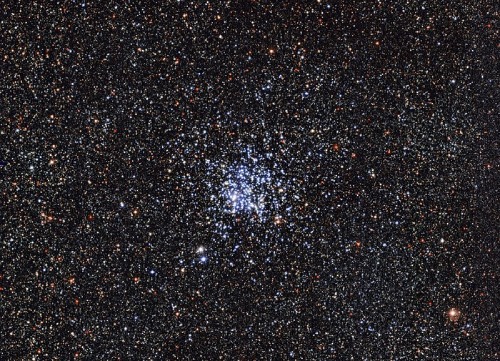Messier 11, commonly known as the Wild Duck Cluster, is an open star cluster located in the small but prominent constellation of Scutum, the Shield. Its name derives from the V-shaped pattern of its brightest stars, which resemble a flock of ducks in flight. Positioned within the dense star fields of the Milky Way, M11 is a favourite target for astronomers, offering a spectacular view when observed with even modest equipment.
The cluster was discovered in 1681 by the German astronomer Gottfried Kirch during observations with a small telescope. Later, in 1764, it was catalogued by Charles Messier as the 11th entry in his list of deep-sky objects. Messier’s catalogue aimed to help astronomers distinguish between comet-like objects and permanent celestial formations such as clusters and nebulae. Over the centuries, M11 has been extensively studied, becoming one of the most well-known and richly populated open clusters in the night sky.
Physical Characteristics
M11 is classified as an open star cluster, a group of stars that formed together from a single molecular cloud. Unlike globular clusters, open clusters like M11 are loosely bound by gravity and tend to disperse over time due to gravitational interactions with nearby stars and molecular clouds.
The Wild Duck Cluster is relatively young, with an estimated age of around 220 million years. Despite its youth on a cosmic timescale, it contains a rich diversity of stars. Located approximately 6,200 light-years from Earth, M11 resides in the Milky Way’s Sagittarius Arm, one of the galaxy’s most star-dense regions.
M11 hosts several hundred stars, with a significant proportion being young, hot blue stars. These stars shine brightly due to their high surface temperatures, giving the cluster its luminous, blue-tinged appearance. Mixed among the blue stars are older, cooler yellow and red stars, which add depth and variety to its visual profile. The compact nature of the cluster suggests that its stars are still relatively close to their birthplace, bound together by mutual gravitational attraction.

Visual Appearance
With an apparent magnitude of 5.8, M11 is one of the brightest open clusters visible from Earth. Under excellent dark-sky conditions, it can be seen faintly with the naked eye, appearing as a hazy patch of light. Binoculars or a small telescope, however, reveal its true splendour—a densely packed collection of stars set against the glittering backdrop of the Milky Way.
The cluster’s striking brightness and compact appearance make it one of the most visually impressive open clusters in the sky. Observed through a telescope, the V-shaped arrangement of its brightest stars becomes apparent, creating the iconic “wild duck” formation that inspired its name. Wide-field views highlight M11’s position within a tapestry of countless stars and nebulous regions, enhancing its beauty as a celestial target.
Observation
M11 is located near the celestial equator, making it observable from both hemispheres. Its position ensures a wide viewing window for stargazers around the world, particularly during its peak visibility months.
In the Northern Hemisphere, the Wild Duck Cluster is best observed during the summer months, when the constellation Scutum reaches its highest point in the evening sky. The cluster becomes visible in late spring, around May, and remains prominent throughout the summer until early autumn, around September. During this period, M11 can be found near the rich star fields of the Milky Way, close to the brighter stars of Scutum and the neighbouring constellations of Sagittarius and Aquila.

In the Southern Hemisphere, M11 is equally well-placed for observation during the same months. The period from June to September, corresponding to the southern winter, offers the clearest views of the cluster. Its position slightly above the southern horizon during these months allows for extended observation times, especially under dark skies away from city lights.
To locate M11, begin by finding the bright star Altair in the constellation Aquila, which forms part of the Summer Triangle asterism. From Altair, trace your way southward along the Milky Way to Scutum, a small yet distinct constellation containing the cluster.



